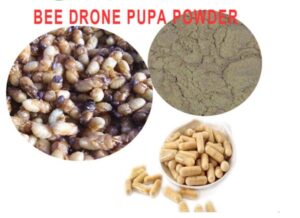
Drone pupae are unfertilized eggs laid by the queen bee in the drone house. After hatching into larvae, they enter the pupal stage (11-12 days old) after 7 days. At this time, the body of the bee pupa is the drone pupae. According to analysis and testing, the 21-day-old has the richest nutritional value.
Freeze-drying (freeze-drying), also known as vacuum freeze-drying, is the most advanced and ideal method for producing high-quality drone bee pupa powder. It maximizes the preservation of the pupae’s nutrients, bioactive substances (such as hormones and enzymes), and natural color and morphology.
The core principle is to first freeze the water in the material into a solid state. Then, under a high vacuum environment, the ice crystals are directly sublimated into water vapor and released, achieving the drying effect. Because the entire process takes place at low temperatures, degradation and oxidation of heat-sensitive substances are effectively avoided.
The following is a detailed process flow for the freeze-dried drone bee pupa powder production process, which can be divided into three stages: pre-treatment, freeze-drying, and post-treatment:
The following is a detailed process flow for the freeze-dried drone bee pupa powder production process, which can be divided into three stages: pre-treatment, freeze-drying, and post-treatment:
Phase 1: Pre-treatment
This is the foundation for ensuring the quality of the final product.
Harvesting & Sorting
Remove the drone pupae from the hive and remove the pupae manually or mechanically.
Critical Control Point: Select high-quality drone pupae that are uniform in age (usually 22-23 days old), intact, milky white or slightly yellowish in color, fresh and uncontaminated. Discard low-quality pupae that are damaged, discolored, or have an odor.
Cleaning & Disinfection
Rinse the pupae under gently running water to remove any impurities such as pollen, honey, and wax.Critical Control Point: A brief soak in low-concentration food-grade saline or ozone water can be used for disinfection. Afterward, rinse thoroughly with purified water to remove any residue.
Draining & Pre-freezing
Spread the cleaned pupae evenly on a tray or sieve and drain thoroughly.
To improve the efficiency of subsequent freeze-drying, pre-freezing is usually performed first. The pupae trays are placed in a quick-freeze room (-30°C to -40°C), where the core temperature is quickly reduced to below the eutectic point (usually below -18°C), forming uniform and fine ice crystals, which better protect the cell structure.
Phase 2: Freeze-Drying – The Core Process
This stage is completed inside the freeze dryer and consists of three sub-stages:
Freezing Stage
The pre-frozen pupae trays are transferred to the shelves within the freeze-drying chamber.
The temperature of the shelves is further lowered and maintained at -35°C to -50°C to ensure the pupae are completely frozen solid. This stage typically lasts 2-4 hours.
Primary Drying – Sublimation Drying
The vacuum pump is activated to reduce the vacuum in the freeze-drying chamber to 10-30 Pa (or even higher).
The shelves are then slowly heated (while maintaining a temperature of -20°C to -10°C) to provide energy for the sublimation of the ice crystals.
Under this low temperature and high vacuum, the solid ice in the pupae sublimates directly into water vapor without passing through the liquid phase. The sublimated water vapor is captured by the condenser (cold trap, typically at -50°C to -80°C) within the chamber and recondenses into frost.
This process takes the longest time, accounting for about 70-80% of the total drying time, and its purpose is to remove most of the free water.
Secondary Drying (Desorption Drying)
After most of the ice crystals have sublimated, the shelf temperature is gradually increased to 20°C to 40°C (the rate of increase must be precisely controlled to prevent product collapse or charring).
During this stage, the vacuum is maintained. The higher temperature breaks the chemical bonds between the material molecules and the bound water, removing any remaining bound water.
After this process, the moisture content of the honey bee pupae typically drops to 2% to 5%, meeting long-term storage standards.
Phase 3: Post-Treatment
Unloading & Inspection
Remove the vacuum and remove the product from the freeze-drying chamber. The freeze-dried drone pupae retain their original shape, but their texture becomes crispy and porous.
Critical Control Point: Inspect moisture content, color, and morphology to ensure they meet standards.
Milling & Sieving
The freeze-dried pupae are placed in a food-grade mill and milled at low temperature (cool air can be introduced to prevent warming).
The milled powder is graded on a vibrating screen to obtain a uniform and fine drone pupae powder (typically 80-120 mesh).
Packaging & Storage
Critical Control Point: Because the freeze-dried product is porous and easily absorbs moisture and oxidizes, it must be packaged in a low-temperature, low-humidity environment, away from light.
Aluminum foil bags are typically used for packaging, filled with an inert gas such as nitrogen to exclude oxygen, and then sealed.
Store in a cool and dry place.
